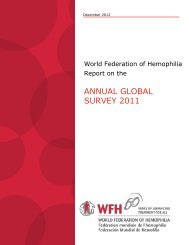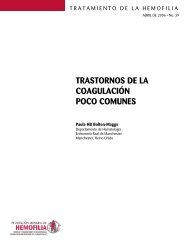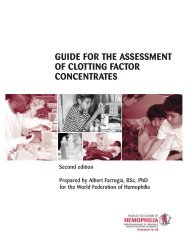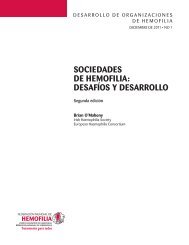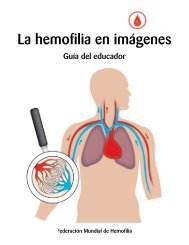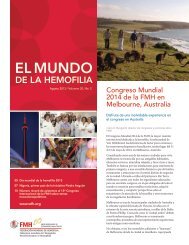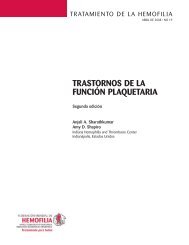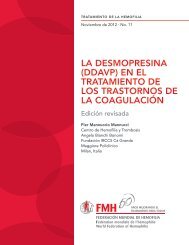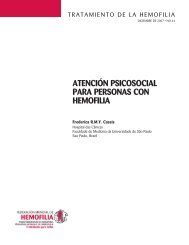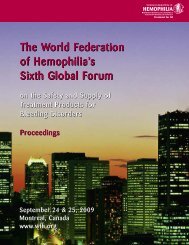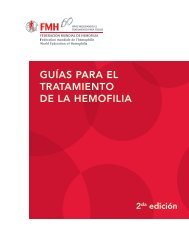musculoskeletal complications of hemophilia: the joint
musculoskeletal complications of hemophilia: the joint
musculoskeletal complications of hemophilia: the joint
You also want an ePaper? Increase the reach of your titles
YUMPU automatically turns print PDFs into web optimized ePapers that Google loves.
Musculoskeletal Complications <strong>of</strong> Hemophilia:<br />
The Joint<br />
Marvin S. Gilbert<br />
Orthopedics is <strong>the</strong> medical specialty that deals with afflictions <strong>of</strong> <strong>the</strong> locomotor system, that is<br />
to say, disorders <strong>of</strong> <strong>the</strong> bones, <strong>joint</strong>s, muscles and peripheral nerves. It is <strong>of</strong> interest that <strong>the</strong><br />
word orthopedics has no direct relationship to any <strong>of</strong> <strong>the</strong>se structures, but is derived from <strong>the</strong><br />
Greek “ortho” (straight) and “pedia” (child). Literally, <strong>the</strong> word means “straight child”. It is<br />
in <strong>hemophilia</strong> that it is most appropriate in that <strong>the</strong> orthopedist is asked to straighten <strong>the</strong> bent<br />
limbs <strong>of</strong> <strong>the</strong> child. However, because <strong>of</strong> hematological advances <strong>of</strong> <strong>the</strong> past decade, it has<br />
become our aim to prevent <strong>the</strong> child from ever becoming bent, to keep <strong>the</strong> child straight so<br />
that he or she can participate in all <strong>the</strong> normal activities <strong>of</strong> his or her peers.<br />
In <strong>the</strong> early 1800s, arthritic <strong>joint</strong>s were reported in persons with <strong>hemophilia</strong>, but it was not<br />
until 1868 that Volkmann stated that in <strong>hemophilia</strong> "bleeding into <strong>joint</strong>s occurred ei<strong>the</strong>r<br />
spontaneously or following minimal trauma." In 1892, König, an orthopedic surgeon,<br />
attempted to operate on several affected knees, but was not able to control bleeding by<br />
surgical means alone. The demise <strong>of</strong> <strong>the</strong><br />
patients allowed him to study <strong>the</strong> <strong>joint</strong> and<br />
he was <strong>the</strong> first physician to show that <strong>the</strong><br />
arthritis associated with <strong>hemophilia</strong> is<br />
directly linked to bleeding into <strong>the</strong> <strong>joint</strong>.<br />
The orthopedic community seemed to<br />
abandon <strong>hemophilia</strong> following König's<br />
failures until <strong>the</strong> 1950s when Henry Jordan<br />
tried to stop bleeding and correct<br />
contractures with casts and braces. In <strong>the</strong><br />
1960s, factor replacement became reality<br />
and many orthopedic interventions,<br />
including physical <strong>the</strong>rapy, surgical tendon<br />
leng<strong>the</strong>ning, <strong>joint</strong> replacement and<br />
arthroscopy could be used to alleviate <strong>the</strong><br />
effects <strong>of</strong> past bleeding. The challenge <strong>of</strong><br />
<strong>the</strong> next century is to prevent any <strong>of</strong> <strong>the</strong>se<br />
<strong>musculoskeletal</strong> <strong>complications</strong> from ever<br />
occurring.<br />
Normal Knee Joint<br />
Illustration by Bernard P. Woschek



